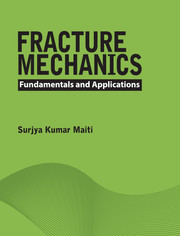Book contents
- Frontmatter
- Dedication
- Contents
- List of Figures
- List of Tables
- Preface
- 1 Introduction
- 2 Linear Elastic Fracture Mechanics
- 3 Determination of Crack-Tip Stress Field
- 4 Crack Opening Displacement, J Integral, and Resistance Curve
- 5 Determination of Stress Intensity Factors
- 6 Mixed Mode Brittle Fracture
- 7 Fatigue Crack Growth
- 8 Elastic Plastic Fracture Mechanics
- 9 Experimental Measurement of Fracture Tougness Data
- Index
- References
1 - Introduction
Published online by Cambridge University Press: 05 February 2016
- Frontmatter
- Dedication
- Contents
- List of Figures
- List of Tables
- Preface
- 1 Introduction
- 2 Linear Elastic Fracture Mechanics
- 3 Determination of Crack-Tip Stress Field
- 4 Crack Opening Displacement, J Integral, and Resistance Curve
- 5 Determination of Stress Intensity Factors
- 6 Mixed Mode Brittle Fracture
- 7 Fatigue Crack Growth
- 8 Elastic Plastic Fracture Mechanics
- 9 Experimental Measurement of Fracture Tougness Data
- Index
- References
Summary
Introduction
Fracture mechanics provides the basis for designing machine and structural components with materials containing defects such as crack, gives rational approach for assessing degree of safety or reliability of an in-service degraded machine component, and helps to calculate the life of a component with crack subjected to cyclically fluctuating load, corrosion, creep, or a combination of all these. A crack is a discontinuity, internal or external (Figs 1.1 and 1.2), in the material with zero tip radius. The development of the subject has been driven by the stringent safety requirements of the aerospace industry, nuclear power plants and other safety-critical applications. The advancement in the understanding of the subject coupled with developments in material science, experimental methods, and numerical techniques such as finite element, boundary element, and meshless methods, has facilitated optimum design and minimization of material usage for an application.
This book presents the gradual development in the fundamental understanding of the subject and in numerical methods that have facilitated its applications. Though the subject can be studied from the viewpoint of material science and mechanics, the focus here is on the latter.
Linear Elastic Fracture Mechanics
Development of the subject originated with the work of Griffith (1921), who propounded the condition of unstable extension of an existing crack in a brittle material within the framework of global energy balance or the First Law of Thermodynamics. The shortcomings of the approach were eliminated by Irwin (1948), who classified the three fundamental modes of crack extension and presented the condition of fracture in terms of a parameter associated with the stress–strain field in the close neighbourhood of the crack-tip. He also showed the link between the crack-tip field parameter, the stress intensity factor (SIF), and the energy release rate parameter introduced by Griffith. These parameters have proved useful in characterizing the fracture of brittle materials and have helped in practical design applications. Brittle materials fracture without showing any plastic deformation before the onset of crack extension or during crack propagation. This type of failure is distinguished by the fact that the fractured parts can be put together to get the original geometry almost reconstructed (Fig. 1.1).
Elastic Plastic or Yielding Fracture Mechanics
Most materials that are used in engineering constructions and machine building are metallic and show plastic deformation around the crack-tip prior to crack extension and during crack extension (Fig. 1.2).
Information
- Type
- Chapter
- Information
- Fracture MechanicsFundamentals and Applications, pp. 1 - 5Publisher: Cambridge University PressPrint publication year: 2015
